Cooking
Austin Butler and Kaia Gerber: Relationship Timeline
Discover the intriguing relationship timeline of Austin Butler and Kaia Gerber, filled with romance and uncertainty—will their journey take a surprising turn?

Austin Butler and Kaia Gerber started dating in late 2021 after being spotted in a yoga class. By December, their relationship was "low-key" confirmed. They made their public debut in March 2022 and celebrated milestones, including Valentine's Day in London and attending the Met Gala together. Throughout 2023, they supported each other at various events, reinforcing their connection and chemistry. However, recent breakup rumors have surfaced, especially after Kaia celebrated her birthday without Austin. Their journey showcases a blend of love and uncertainty, hinting at an evolving dynamic that fans might find intriguing.
Key Takeaways
- Austin Butler and Kaia Gerber began dating in late 2021, confirmed their relationship in December 2021, and made their public debut in March 2022.
- They celebrated significant milestones together, including their first Valentine's Day in London and Austin's Golden Globe win in January 2023.
- The couple has consistently supported each other at award shows and high-profile events, including the Met Gala and Cannes Film Festival.
- Recent speculation about their relationship arose from Kaia's solo birthday celebration and social media hints suggesting a potential single status.
- Despite breakup rumors and public appearances together, sources confirmed no immediate plans for engagement or marriage, leaving their future uncertain.
Relationship Beginnings

Austin Butler and Kaia Gerber's relationship kicked off in late 2021, with rumors swirling after they were spotted together at a yoga class. This sighting came shortly after Kaia's breakup with Jacob Elordi, sparking interest among fans and media alike.
By December 23, sources confirmed that they were "officially low-key dating," enjoying each other's company and embracing the early stages of their relationship. Their budding romance echoed the charm seen in other celebrity couples, reminiscent of Paula Deen's Wedding Highlights that celebrated love and connection.
In January 2022, exclusive photos emerged of the couple on a casual supermarket date in Los Angeles, showcasing their affectionate nature. They looked comfortable and relaxed together, hinting at the chemistry that had drawn them to one another.
As February rolled around, they celebrated their first Valentine's Day together while in London, further solidifying their romantic bond.
Despite the scrutiny that comes with being in the public eye, Austin and Kaia appeared to navigate their relationship with ease, maintaining a low-key vibe. Their connection blossomed, leading to their public debut at W Magazine's Best Performances party in March 2022, where they were photographed holding hands and radiating affection.
This marked a significant milestone in their budding romance.
Public Debut and Milestones

The couple made a splash in the public eye during their debut at W Magazine's Best Performances party on March 24, 2022, where they were photographed holding hands and exuding warmth.
This moment marked the beginning of their journey together in the spotlight, and fans enthusiastically followed their relationship timeline from there. As their connection blossomed, it served as a reminder of how maintaining an organized and decluttered life can foster emotional well-being, creating a space to celebrate love and relationships the mental benefits of decluttering.
Here are some key milestones that showcased their budding romance:
- Valentine's Day 2022: Austin Butler and Kaia Gerber celebrated their first Valentine's Day together in London, enjoying a cozy coffee date.
- Met Gala 2022: On May 2, they walked the red carpet at the Met Gala, with Kaia dazzling in a metallic Alexander McQueen gown and Austin looking sharp in a black Prada suit.
- Cannes Film Festival 2022: They were spotted kissing at the Cannes Film Festival on May 25, further solidifying their connection.
Their appearances continued to impress, including a playful moment at the Vanity Fair Oscars afterparty on March 12, 2023, where they were seen smiling and showing affection.
Each event added to the charm of their relationship.
Supportive Appearances

When it comes to supportive appearances, you'll notice how Austin and Kaia consistently show up for each other during important events.
Their affection is reminiscent of how public figures navigate their personal narratives under scrutiny, as seen in the case of J.D. Vance's peculiar remarks.
Whether it's award shows or fashion showcases, their dedication to one another is evident through their presence and affection.
These moments highlight not just their romance, but also their commitment to each other's careers and families.
Award Show Attendance
Stepping onto the red carpet together, Austin Butler and Kaia Gerber instantly captured attention with their undeniable chemistry and stylish ensembles. Their award show attendance has been a significant part of their relationship timeline, showcasing their unwavering support for one another.
The couple's choice of attire often reflects the event's theme, similar to how attire for different cruises can enhance the onboard experience.
- Met Gala 2022: The couple made their red carpet debut, turning heads with their fashionable styles and evident affection.
- Golden Globe Win (January 2023): Kaia celebrated Austin's win backstage, sharing a passionate kiss that was beautifully captured on video.
- Time100 Gala (April 2023): Kaia dazzled in a skin-tight gray dress, proudly supporting Austin as he was honored as one of the most influential figures for his role in "Elvis."
Their presence at the Vanity Fair Oscars afterparty in March 2023, where they were seen smiling and enjoying each other's company, further solidified them as a supportive couple.
Even their attendance at the London premiere of "Dune: Part Two" in February 2024 highlights their commitment to standing by one another in both personal and professional arenas.
Public Displays of Affection
Public displays of affection between Austin Butler and Kaia Gerber reveal the depth of their bond and commitment to one another. They made their public debut as a couple at W Magazine's Best Performances party on March 24, 2022, where they were seen holding hands and sharing smiles.
Their strong connection resonates within the celebrity lifestyle narrative, showcasing how high-profile relationships capture public interest. Their first Valentine's Day together on February 14, 2022, in London showcased their romantic connection as they enjoyed coffee and snacks.
At the Met Gala on May 2, 2022, Kaia and Austin shared a tender moment on the red carpet, radiating chemistry that caught the attention of fans and photographers alike. Their affectionate moments continued at the Cannes Film Festival on May 25, 2022, when they were photographed sharing a kiss during the premiere of "Elvis," further solidifying their public displays of affection.
Throughout their relationship, you can frequently spot them holding hands and displaying PDA during various outings. Whether it's a romantic date night in Paris or at the Vanity Fair Oscars afterparty on March 12, 2023, Austin Butler and Kaia Gerber consistently demonstrate their love and support for each other in the spotlight.
Family Support Engagements
Supportive appearances between Austin Butler and Kaia Gerber highlight their strong family ties and commitment to each other.
Their relationship timeline shows how they seamlessly blend their personal lives with family support, making significant moments even more special.
Here are some notable instances:
- Golden Globe Celebration: On January 10, 2023, Kaia passionately celebrated Austin's Golden Globe win with him backstage, showcasing their supportive dynamic during significant events.
- Double Date with Parents: On May 25, 2023, the couple enjoyed a double date with Kaia's parents, Cindy Crawford and Rande Gerber, at Roberta's in Culver City, California, reinforcing their family connections.
- New Year's in Cabo San Lucas: Early in their relationship, they spent New Year's 2022 in Cabo San Lucas with Kaia's family, indicating a strong blend of their personal and family lives.
These moments illustrate how both Austin Butler and Kaia Gerber prioritize family support in their relationship, ensuring they stand by each other during life's most significant events.
Awards Season Highlights

Awards season in 2023 was a remarkable time for Austin Butler and Kaia Gerber, showcasing their deepening relationship amidst the glitz and glamour of Hollywood.
Austin won the Golden Globe for Best Actor in Motion Picture Drama in January, and you could see how proud Kaia was as she celebrated backstage with him. This milestone marked a significant moment in their journey together.
The couple continued to shine at the Vanity Fair Oscars afterparty in March, where they were photographed smiling and enjoying each other's company, highlighting their unwavering support for one another during awards season.
In April, Kaia joined Austin at the Time100 Gala, where he was recognized as one of the most influential figures, further showcasing their partnership at high-profile events.
Their relationship made a memorable entrance at the 2022 Met Gala, marking their red carpet debut.
Kaia dazzled in a striking metallic Alexander McQueen gown, while Austin looked dapper in a classic black Prada tuxedo.
Throughout the 2023 awards season, Austin and Kaia were frequently seen together, reinforcing their bond and public presence as a couple in the spotlight.
Media Coverage Overview

Austin Butler and Kaia Gerber's relationship has consistently captured the media's attention, especially since their high-profile appearances during awards season.
Major outlets like AFP and PEOPLE have been all over their romance since it began in December 2021, highlighting key milestones and public appearances that keep fans buzzing.
Here are three notable aspects of their media coverage:
- Public Debut: Their relationship gained significant traction after they were photographed holding hands at W Magazine's Best Performances party in March 2022.
- High-Profile Events: The couple's appearances at prestigious events like the Met Gala and Cannes Film Festival solidify their status as an "It couple" in the fashion and entertainment industries.
- Social Media Buzz: Affectionate displays, such as kisses and coordinated outfits, fuel social media chatter, keeping fans engaged and speculating about their relationship.
Relationship Dynamics

In the vibrant world of Hollywood, the relationship dynamics between Kaia Gerber and Austin Butler stand out for their playful and affectionate connection. Their chemistry is palpable, often showcased through public affection like hand-holding and shared kisses at events. This display reinforces the strong bond they share, enthralling fans and onlookers alike.
Despite their 10-year age gap, you'll find no signs of jealousy or insecurity between them. Instead, their relationship reflects a down-to-earth connection that prioritizes mutual support. Kaia actively celebrates Austin's achievements, attending key events like the Golden Globes, showing her unwavering encouragement.
Moreover, their shared interests in health and wellness enhance their relationship dynamics. You can often spot them engaged in fitness activities together, whether it's at the gym or enjoying outdoor workouts. This focus on wellness not only strengthens their bodies but also deepens their affectionate connection.
In this whirlwind of fame, Austin Butler and Kaia Gerber show that a solid relationship thrives on chemistry, support, and shared passions, making their bond even more remarkable in the spotlight.
Recent Developments

Recently, you might've heard whispers about breakup rumors surrounding Austin Butler and Kaia Gerber, despite their continued public appearances.
They've been spotted together at various events, showcasing their bond even amidst speculation.
However, their future plans remain uncertain, leaving fans curious about what's next for the couple.
Breakup Rumors Surface
Rumors of a breakup between Austin Butler and Kaia Gerber have started to swirl, particularly after Gerber was spotted with SNL star Marcello Hernandez at a party in September 2024. This sighting ignited speculation about their relationship status, especially since Austin wasn't present at key moments in Kaia's life.
Several factors have contributed to the growing breakup rumors:
- Kaia celebrated her 23rd birthday at Disneyland without Austin, raising eyebrows about their connection.
- In August 2023, Kaia posted a picture of herself with the book "Dear D*ckhead," which fans interpreted as a hint at her potential single status.
- The couple's recent silence contrasts sharply with their previous public appearances and affectionate interactions, leaving fans puzzled.
Despite the buzz, neither Austin Butler nor Kaia Gerber has publicly addressed the breakup speculation, creating further intrigue around their relationship.
The combination of these elements has left you and many others wondering about their future together and whether the affectionate interactions they once shared are now just a memory.
Public Appearances Continue
Despite the swirling breakup rumors, Austin Butler and Kaia Gerber continue to make notable public appearances together, showcasing their relationship. Their connection was particularly evident during Paris Fashion Week on July 5, 2023, when the couple enjoyed a romantic date night in Paris, holding hands at a restaurant inside Hotel Costes.
Their relationship also gained attention when they engaged in a double date with Kaia's parents at Roberta's in Culver City, California, on May 25, 2023, highlighting their commitment.
Austin was recognized as one of the most influential figures at the Time100 Gala on April 26, 2023, where Kaia dazzled in a skin-tight gray dress. Supporting each other at significant events, Kaia attended the Vanity Fair Oscars afterparty on March 12, 2023, in honor of Austin, who was nominated for Best Actor for his role in "Elvis."
Throughout 2023, the couple has been spotted at various public events, including the screening of "The Boys In The Boat" in December and the London premiere of "Dune: Part Two" in February 2024, further solidifying their status as a fashionable and committed couple.
Future Plans Uncertain
Austin Butler and Kaia Gerber's relationship has entered a phase of uncertainty, with several factors raising eyebrows about their future together. Recent developments have stirred speculation, especially following Gerber's social media posts that hinted at a potential single status.
Their once-supportive partnership, highlighted by their appearances at public events like the Golden Globes and the Met Gala, now faces increasing scrutiny.
You might notice these key points:
- Breakup Rumors: In September 2024, Gerber was spotted with SNL star Marcello Hernandez, fueling speculation about their relationship status.
- Absence from Public Events: After enjoying outings like a romantic dinner and a Taylor Swift concert in August 2023, their recent lack of appearances together raises questions.
- Engagement Rumors Denied: A source confirmed in May 2023 that while their bond is serious, they aren't heading towards marriage anytime soon.
As you follow Austin Butler and Kaia Gerber's journey, it's crucial to keep an eye on how these developments unfold, as their future plans remain shrouded in uncertainty and speculation.
Frequently Asked Questions
How Long Did Austin Butler and Kaia Gerber Date?
You'll find that Austin Butler and Kaia Gerber have been dating for nearly two years as of October 2023. Their relationship began in December 2021, showcasing a strong bond that's continued to flourish.
What Is the Age Gap Between Kaia and Austin?
When you think of timeless pairs, age gaps often come to mind. In this case, there's a 10-year difference between Kaia and Austin, but their connection shows that love transcends numbers and societal expectations.
Did Austin Butler Propose to Kaia Gerber?
No, Austin Butler hasn't proposed to Kaia Gerber. Despite their strong connection and serious relationship, there's been no public announcement or indication of an engagement. They seem to prioritize privacy in their romance.
Is Austin Butler in Love With Kaia?
Isn't love often wrapped in shared laughter and gentle glances? You can see the spark between them; it's clear Austin's feelings for Kaia run deep, showcasing a genuine affection that's hard to ignore.
Conclusion
Austin Butler and Kaia Gerber's relationship has evolved beautifully, marked by shared milestones and public support. Their bond, built on mutual admiration and resilience, showcases how love can thrive in the spotlight. As they continue to navigate the ups and downs of fame together, one can't help but wonder: what's next for this dynamic duo? With each step they take, their journey captivates fans and reminds us that love often flourishes amidst the chaos of life.
Cooking
The Science Behind ‘Supertasters’ and Their Genetic Makeup
Get ready to uncover the fascinating genetic traits of supertasters and discover how they experience taste differently—what secrets lie in their unique palates?
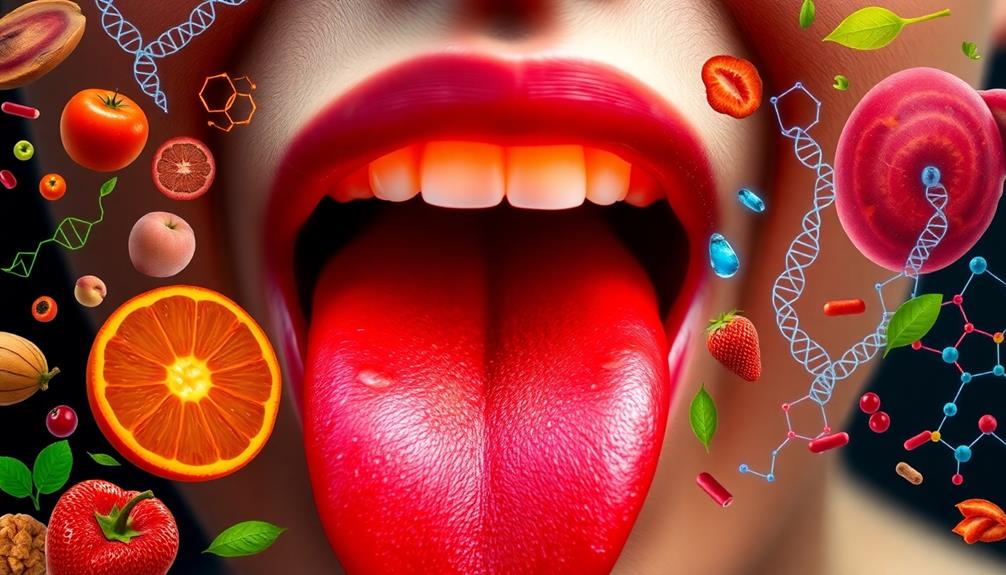
Supertasters are special because about 25% of people have a unique genetic makeup that affects their taste perception. You see, they have more taste buds—up to 60 in a tiny section of their tongue. This heightened sensitivity makes them particularly attuned to flavors, especially bitterness, linked to the TAS2R38 gene. If you're a supertaster, you likely avoid bitter vegetables like broccoli and prefer sweeter foods instead. While this can influence your diet, it also helps you enjoy vibrant flavors. Curious about how these traits affect eating habits and culinary experiences? There's plenty more to explore!
Key Takeaways
- Supertasters have heightened taste sensitivity due to increased taste bud density, resulting in intense flavor experiences.
- The TAS2R38 gene, particularly the PAV allele, is linked to strong sensitivity to bitterness in supertasters.
- Approximately 25% of the population qualifies as supertasters, with significant variations in taste perception globally.
- Supertasters typically prefer sweeter and milder foods, avoiding bitter options like broccoli and coffee, which impacts their dietary choices.
- Their unique taste sensitivity can lead to nutritional implications, as they may limit dietary variety due to aversions to certain flavors.
Understanding Supertasters
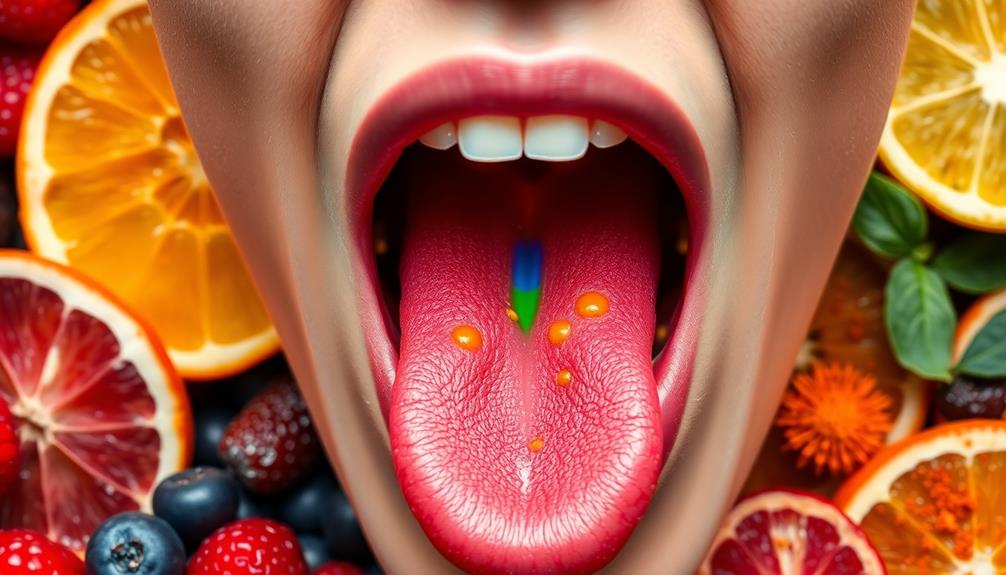
Understanding supertasters can transform how you think about taste. If you're among the 25% of people classified as supertasters, you have a heightened sensitivity to flavors due to a greater density of taste buds, especially the fungiform papillae. This means your experience of taste is markedly more intense than that of average tasters.
You might find yourself particularly sensitive to bitterness, which is largely linked to the TAS2R38 gene. This gene amplifies your perception of bitter compounds found in foods like broccoli and coffee, often leading you to avoid these flavors altogether.
Curiously, supertasters might also experience strong reactions to spiced dishes, such as Mushroom Masala, which are rich in complex flavor profiles. With anywhere from 35 to 60 taste buds in a six-millimeter section of your tongue, compared to just 15 to 30 for average tasters, your palate is finely tuned.
This heightened sensitivity can create selective food preferences, pushing you away from certain foods that might be enjoyed by others. If you're curious about your taste perception, genetic testing can reveal your status as a supertaster.
Understanding this unique aspect of your taste experience can enhance your culinary adventures and help you navigate flavors more effectively.
Genetic Basis of Taste Perception
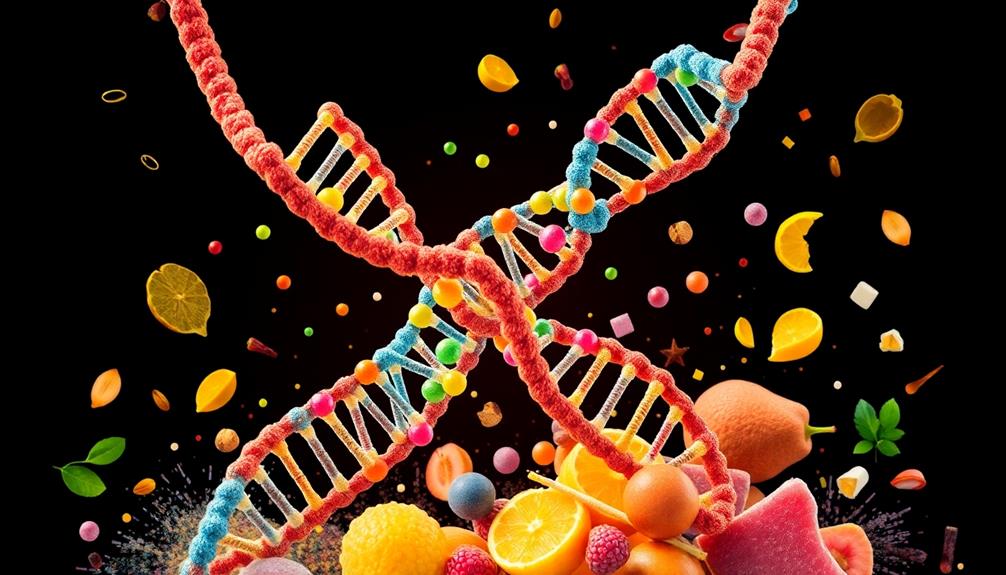
How does your genetic makeup influence your taste perception? Your sensitivity to flavors, especially bitter ones, is largely determined by genetic variation in the TAS2R38 gene. This gene plays an essential role in how you perceive bitter taste.
If you have specific alleles, like the PAV allele, you may experience heightened bitterness, affecting your food preferences and dietary choices. For example, those with heightened sensitivity might avoid certain dishes, such as Red-Braised Pork Belly, known for its rich flavors.
About 25% of people are classified as supertasters, a status linked to this genetic variation. Supertasters have more taste buds than average, amplifying their sensitivity to flavors. This heightened bitter taste perception often leads them to avoid certain foods, such as Brussels sprouts or coffee, that others might enjoy.
Genetic testing can help you discover whether you're a supertaster by analyzing the expression of these taste receptor genes. Notably, the distribution of tasters and non-tasters varies across different populations, underscoring how genetic factors shape taste experiences globally.
Characteristics of Supertasters
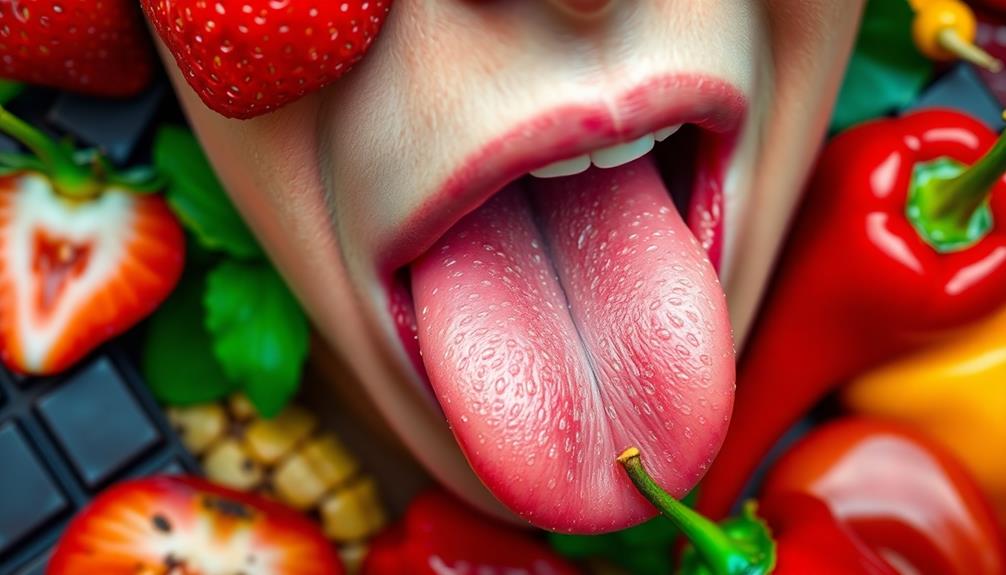
Supertasters are a unique group, making up about 25% of the population, distinguished by their heightened taste sensitivity due to a greater density of taste buds. If you're a supertaster, you likely have a variant of the TAS2R38 gene, which heightens your perception of bitterness in foods.
This heightened sensitivity often leads to strong aversions to bitter vegetables like broccoli and spinach, which can be overwhelming for your palate. Notably, this sensitivity can also affect your preferences for certain cuisines, as dishes like Hiyashi Chuka offer invigorating flavors that may appeal more to your palate than others.
You probably prefer sweeter or milder foods, steering clear of overly bitter flavors. Because of your acute sensitivity, you might avoid certain alcoholic beverages that have pronounced bitter notes, such as IPAs or dry wines. This distinctive way of tasting influences your food choices, leading to selective eating patterns that can impact your nutritional intake.
Being a supertaster can make dining out or trying new foods a bit more challenging, as you may find yourself less inclined to enjoy dishes that others rave about.
Understanding your unique taste preferences can help you make more informed dietary choices, ensuring that your meals are as enjoyable and satisfying as possible.
The Role of Taste Buds
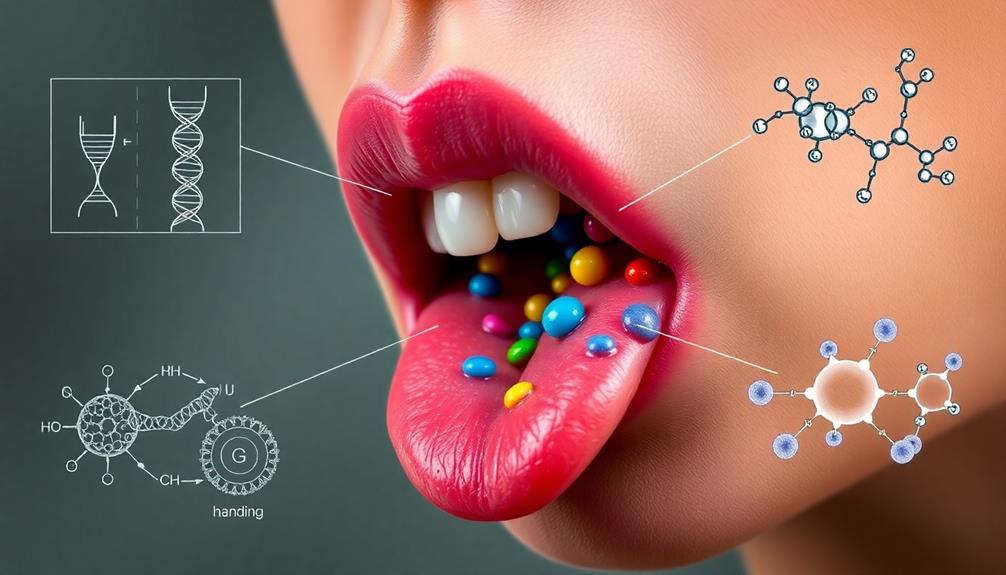
Taste perception starts with the intricate network of taste buds on your tongue, which play an essential role in how you experience flavors. Your tongue is covered in taste papillae, housing three types: fungiform, circumvallate, and foliate. These papillae contain taste buds, each made up of about 50 to 150 taste receptor cells, vital for detecting different tastes.
Notably, the diverse flavors found in Brazilian cuisine can be particularly impactful for super-tasters, as their heightened sensitivity to flavors allows them to fully appreciate the unique ingredients and spices used in traditional dishes.
If you're a super-taster, you likely have a higher density of taste buds—around 35 to 60 per six-millimeter section of your tongue. This abundance heightens your sensitivity to flavors compared to average tasters and non-tasters. The TAS2R38 gene plays a significant role here, particularly influencing your perception of bitter flavors, which can make certain foods more intense for you.
The physiological structure of your taste buds includes Type I support cells, Type II receptor cells for sweet, bitter, and umami sensations, and Type III presynaptic cells, each contributing to your overall taste experience.
This complex interplay of taste buds and receptor cells is what sets super-tasters apart, allowing you to savor flavors in a unique way.
Impact on Food Preferences
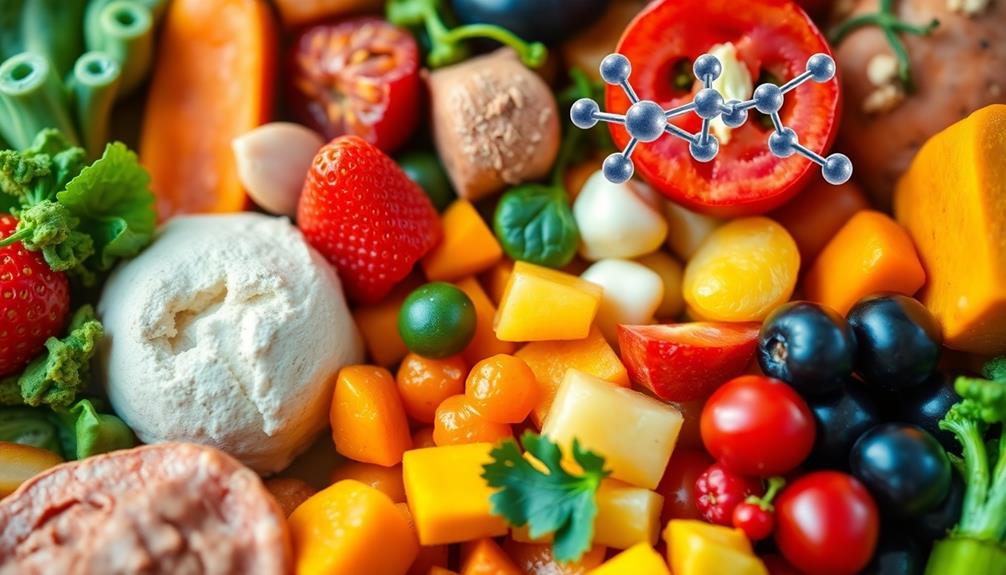
With a heightened sensitivity to flavors, supertasters often find their food preferences shaped markedly by their unique genetic makeup. You might notice that your palate leans toward sweeter or milder options, steering clear of bitter foods like broccoli or coffee. This aversion stems from the TAS2R38 gene, which influences your perception of bitterness. As a supertaster, you may even prefer high-salt foods, as they can offset bitterness and enhance flavors in dishes you might otherwise avoid.
Here's a breakdown of how your food preferences might differ:
| Food Category | Preference Level |
|---|---|
| Bitter Foods | Low |
| Sweet Foods | High |
| Salty Foods | Moderate to High |
| Processed Foods | Low |
| Healthier Options | High |
Your selective eating habits could lead to a lower risk of certain diseases, as you may consume fewer unhealthy foods. Embracing your supertaster traits can help you craft a diet that's not only enjoyable but potentially beneficial for your health.
Sensitivity to Bitterness
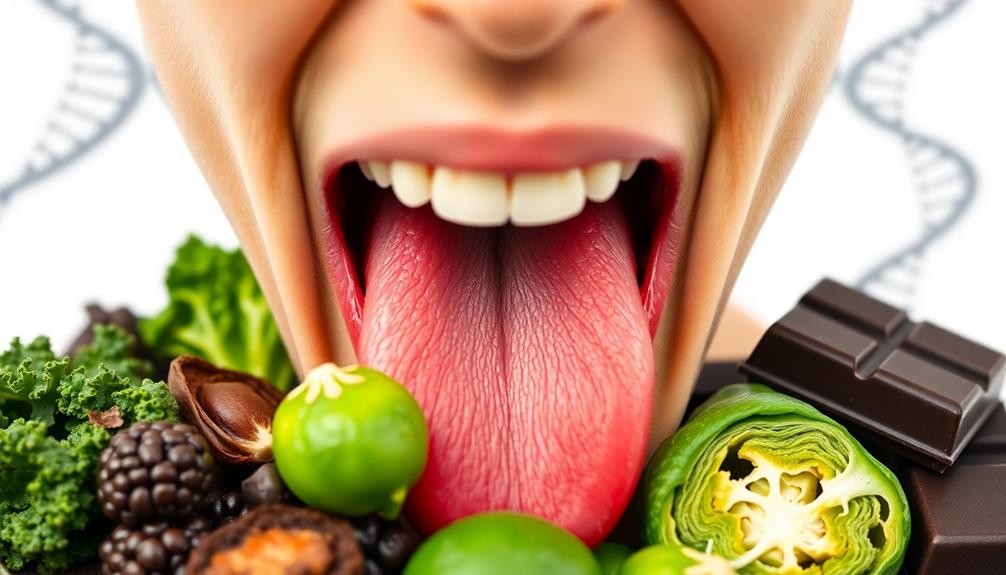
Your unique genetic makeup not only shapes your food preferences but also influences how you perceive bitterness. If you're a supertaster, you likely have heightened sensitivity to bitterness, which means you experience these flavors more intensely than average tasters. This sensitivity is often linked to the TAS2R38 gene, particularly the PAV allele, which makes you more responsive to bitter compounds like phenylthiocarbamide (PTC).
Notably, this heightened sensitivity can also affect your enjoyment of certain foods, including traditional dishes such as Ethiopian salad, which are often fresh and vibrant, potentially appealing to supertasters.
Approximately 25% of the population are classified as supertasters, and this distinct palate often leads to strong aversions to foods that are bitter, like broccoli and coffee. Research shows that supertasters can differentiate between varying levels of bitterness more accurately than non-tasters.
This ability affects your food choices and dietary habits, as you might find yourself avoiding certain bitter foods that others consume without issue.
In essence, your sensitivity to bitterness not only shapes what you enjoy eating but also influences your overall culinary experiences. Understanding this aspect of your taste perception can help you navigate your food preferences more mindfully, allowing for a better appreciation of flavors you do enjoy.
Nutritional Implications
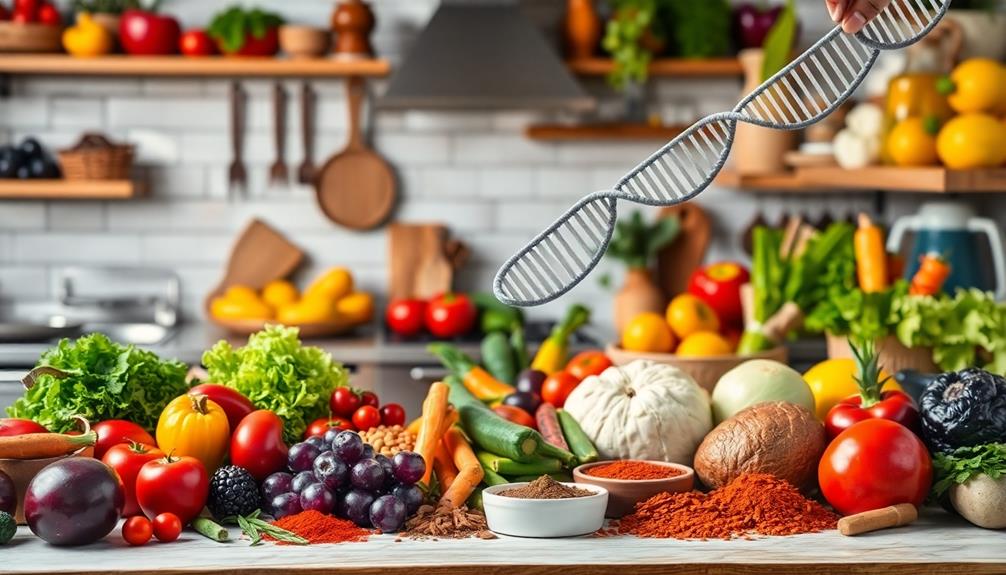
For supertasters, traversing the world of nutrition can be a complex journey shaped by their heightened sensitivity to bitter flavors. Your enhanced taste receptors can make certain nutrient-rich foods, like broccoli and spinach, seem unpalatable. This aversion might lead you to gravitate towards dishes that are more appealing to your palate, such as Southern comfort food, which often features milder and sweeter flavors that can sometimes mask bitterness.
As a result, you might find yourself avoiding these vegetables, which could lead to nutrient deficiencies over time. Additionally, your aversion to bitterness may cause you to prefer sweeter or milder foods, impacting your dietary variety. While this might seem enjoyable initially, it can restrict your nutritional intake, potentially influencing your overall health.
You may also notice that your calorie consumption tends to be lower, as you shy away from strong-tasting foods. This could aid in weight management, but it may not always be beneficial. Your acute sensitivity to bitterness might even extend to alcoholic beverages, limiting your social experiences and further narrowing your dietary choices.
Balancing your preferences with a varied diet becomes essential to guarantee you're meeting your nutritional needs. Embracing a broader range of flavors, including those you find less appealing, can help you maintain a healthier, more balanced diet.
Community and Research Engagement
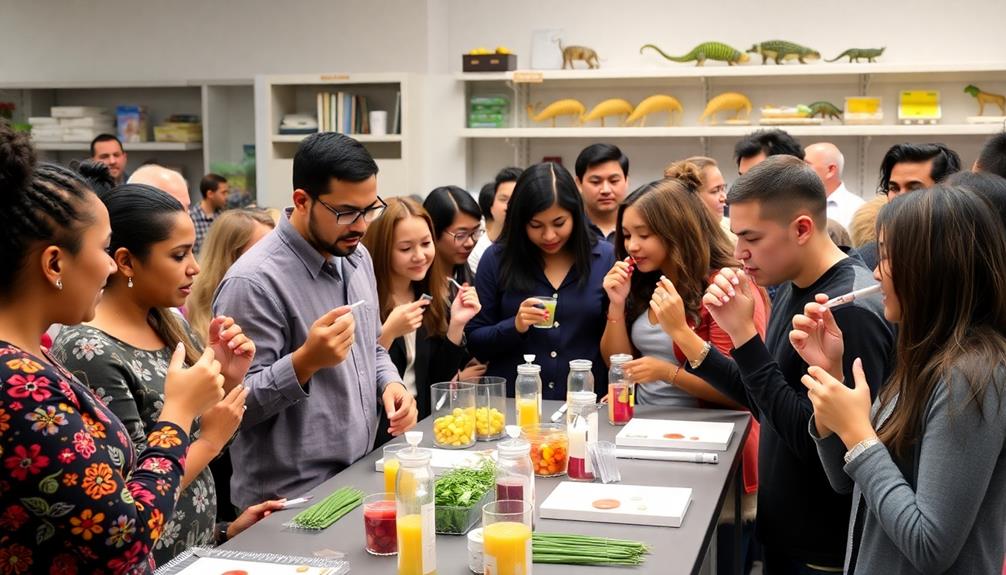
Exploring the complexities of taste perception and nutrition can open doors to a vibrant community of individuals enthusiastic to share their experiences and insights.
Engaging in discussions about spooky snack ideas during Halloween can also enhance your understanding of how flavors may be perceived differently by supertasters. When you immerse yourself in genetic research, particularly the Bitter Taste trait report from 23andMe, you gain valuable information about your supertaster status and how it impacts your palate.
Engaging with this DNA community enables you to connect with others who share similar interests in taste genetics. Community features, such as discussion forums and newsletters, create an environment where you can exchange knowledge and learn from others' experiences.
These platforms encourage dialogue about how genetics influences taste perception, shaping dietary choices and preferences. Staying informed about the latest findings in genetic research is essential, especially as new studies emerge that enhance our understanding of supertasters.
Frequently Asked Questions
What Is the Evolutionary Reason for Supertasters?
You've evolved as a supertaster to better detect bitter flavors in food. This heightened sensitivity helps you avoid potentially toxic substances, enhancing your survival by guiding you toward safer, more nutritious choices in your environment.
Why Are Some People Called Supertasters and What Makes Them Different From the Average Person?
About 25% of folks are supertasters, meaning you might have more taste buds than average. This sensitivity makes you experience flavors more intensely, often leading to pickier eating habits and stronger aversions to certain foods.
What Might Be the Genetic Advantage or Disadvantage of Being a Super Taster?
Being a supertaster gives you a genetic advantage by enhancing taste sensitivity, helping you avoid harmful substances. However, it can also limit your diet, making social dining experiences uncomfortable and potentially leading to nutrient deficiencies.
Who Is More Likely to Be Supertasters?
Ever wondered who's more likely to be supertasters? Well, you might be surprised! Research shows that women often outnumber men in this category, but it's not just about gender—genetics play a vital role too.
Conclusion
In exploring the fascinating world of supertasters, you uncover the intricate dance of genetics and taste. Just like a fine wine reveals its layers, your palate might be more discerning than you think. Embracing your unique taste experience can lead to healthier choices and a deeper appreciation for food. So, whether you're savoring a gourmet meal or dodging bitter greens, remember, your taste buds are part of a grand symphony, playing their own beautiful notes in the culinary orchestra.
Cooking
How Lunar Cycles Influence Shellfish Flavor
Not only do lunar cycles impact shellfish flavor, but they also reveal fascinating connections between nature and taste—discover how this celestial dance unfolds!

Lunar cycles play a huge role in determining shellfish flavor, especially oysters. You'll notice that during new moons, oysters tend to open their shells more, adjusting their feeding patterns to optimize food intake. This feeding is essential since phytoplankton, a key food source, peaks at this time. Additionally, lunar phases influence spawning patterns, ensuring larvae are released when conditions are most favorable. The timing of these natural behaviors links directly to the rich flavors you enjoy in shellfish. Want to explore how these celestial shifts shape the flavors you taste? Keep going for deeper insights!
Key Takeaways
- Lunar cycles affect oyster behavior, leading to increased shell opening and feeding during new moons, which enhances flavor profiles.
- Nutrient availability peaks around new moons, providing abundant phytoplankton that contributes to better oyster taste.
- Tidal changes, influenced by lunar cycles, bring nutrient-rich waters essential for shellfish growth and flavor enhancement.
- Oysters synchronize spawning with lunar phases, ensuring optimal conditions for larvae, which supports population health and flavor.
- Artificial lighting disrupts natural lunar behaviors, potentially impacting the flavor profiles of shellfish.
Lunar Cycles and Shellfish Behavior

Lunar cycles greatly influence shellfish behavior, particularly in oysters. You'll notice how these captivating creatures open their shells more during new moons and close them tightly during full moons. This pattern isn't just about protection; it directly affects their feeding behavior. Oysters rely on lunar cues to maximize food availability, allowing them to filter feed effectively when conditions are best.
Curiously, similar to the way the flavors of Red-Braised Pork Belly develop with careful timing, the oysters' feeding aligns with the lunar phases for maximum efficiency.
What's even more fascinating is how oysters synchronize their spawning with lunar phases. They release their gametes during specific lunar cycles, enhancing their reproductive success. This timing guarantees that their offspring have the best chance of survival, coinciding with ideal environmental conditions.
The internal lunar clock of oysters operates independently of light intensity, showing their remarkable ability to track lunar cycles. This behavior isn't exclusive to oysters; various marine species, like corals and certain crabs, also align their reproductive activities with the moon, highlighting a broader ecological impact.
Impact of Moonlight on Oysters

You might be surprised to learn that moonlight greatly influences oyster behavior, especially their feeding patterns.
During different lunar phases, oysters open their shells more or less, adjusting to optimize food intake. This fascinating relationship with their environment mirrors how traditional dishes like Muamba De Galinha are celebrated for their rich flavors and cultural importance.
This synchronization with the moon can enhance their flavor, making it essential for you to reflect on lunar cycles when enjoying these delicacies.
Lunar Cycle Effects
Oysters display captivating behaviors in response to lunar cycles, particularly in how their shells open and close. During the lunar cycle, you'll notice that oysters are most open near new moons and least open during full moons. This shell opening pattern directly impacts their feeding patterns and, consequently, their flavor profiles.
Curiously, many traditional Brazilian dishes, such as Caldeirada, highlight the importance of seafood, showcasing the rich flavors that can be achieved through careful sourcing and preparation. Research shows that Pacific oysters (Crassostrea gigas) use an internal lunar clock to time their feeding with ideal plankton availability, which fluctuates with lunar phases. When their shells are wide open, they filter feed more effectively, allowing them to intake more nutrients. This increased nutrient absorption enhances their flavor, making them more desirable during specific lunar phases.
Curiously, even though moonlight is less intense than sunlight, it still plays a significant role in their behavior. The ecological sensitivity of oysters to these lunar cycles raises concerns about the effects of artificial lighting on their natural habits and the potential impact on their flavor profiles.
Feeding Behavior Changes
The rhythmic changes in shell opening behavior are closely tied to the influence of moonlight, which greatly affects oyster feeding patterns. Oysters, particularly during new moons, open their shells wider and more frequently to enhance feeding on plankton.
Research shows that these bivalves respond to lower moonlight conditions by increasing their feeding activity, capitalizing on food availability in the water column. Curiously, just as certain Indonesian dishes like Kue Putu are best enjoyed warm, oysters may also exhibit improved flavor profiles during ideal feeding times.
A study monitoring Pacific oysters (Crassostrea gigas) over three lunar cycles revealed that they opened their shells every 1.6 seconds, indicating a clear lunar rhythm in their feeding behavior. This synchronization with lunar cycles suggests that oysters may strategically time their feeding to match the movement of plankton, enhancing their chances of nutrient intake.
Understanding how moon phases influence oyster behavior not only sheds light on their feeding habits but also hints at seasonal variations in oyster flavor. When you consider the relationship between lunar patterns and nutrient availability, it becomes evident that the oysters you enjoy may taste better during specific lunar conditions.
This connection between moonlight and feeding behavior is essential for appreciating the complex factors that contribute to the unique flavor profiles of oysters.
Nutrient Availability and Flavor

Nutrient availability plays an essential role in shaping the flavor of shellfish, particularly oysters, which thrive in environments rich in microscopic algae and plankton. The lunar cycles profoundly influence this nutrient availability, especially during new moons when phytoplankton populations may peak.
As you observe oysters in their natural habitat, you'll notice that their spawning timing is closely linked to these lunar phases, ensuring that larvae hatch when nutrient conditions are best. This synchronization enhances the growth and flavor profile of adult oysters.
The quality of shellfish, like oysters, can also be influenced by seasonal dishes such as Nettle and Potato Soup, which highlight the importance of fresh, local ingredients. During specific lunar phases, the abundance of phytoplankton—oysters' primary food source—can fluctuate, impacting their growth rate and flavor.
Research shows that oysters cultivated in nutrient-rich conditions, often associated with certain lunar cycles, develop more robust flavor profiles, making them more marketable. By understanding the interplay between lunar cycles and nutrient availability, you can appreciate how these factors contribute to the unique taste of oysters.
Tidal Changes and Shellfish Growth

Tidal changes play a significant role in the growth of shellfish, particularly in how they interact with their environment. The regular tidal movements bring nutrient-rich ocean water into their habitats, providing a constant food source. As you observe the tides, you'll notice how they support the shellfish's feeding habits, allowing them to filter feed on microscopic algae and plankton. The turbulence from these currents also oxygenates the waters, promoting metabolic processes that enhance both health and flavor.
Moreover, tides influence shellfish spawning, as they help disperse larvae into suitable marine environments. This movement is vital for recruitment and population dynamics, which directly impact growth and overall flavor. Salinity levels, regulated by the mixing of freshwater and saltwater during tidal changes, further affect shellfish development. They thrive in specific salinity conditions, which can enhance their flavor profiles.
| Tidal Effect | Impact on Shellfish Growth |
|---|---|
| Nutrient Inflow | Essential for feeding and flavor |
| Oxygenation | Supports metabolic health |
| Spawning Timing | Aids larvae dispersal |
| Salinity Regulation | Influences growth and flavor |
Reproductive Patterns in Shellfish

Synchronizing their reproductive patterns with lunar cycles, many shellfish have developed unique strategies to maximize their spawning success. Oysters, for instance, release their eggs and sperm mainly during specific lunar phases, particularly around new moons. This timing enhances their chances of successful fertilization and larval dispersal.
During these lunar events, you'll notice oysters exhibit increased shell opening and feeding activity, aligning with ideal nutrient availability. The rich flavors of shellfish, much like those found in Mushroom Masala, can also be attributed to their health and liveliness during these reproductive periods.
Research shows that oyster spawning occurs mainly in warmer months, influenced by not just lunar cycles, but also environmental cues like temperature and photoperiod. Similarly, palolo worms engage in synchronized broadcast spawning on specific days in October and during the last quarter moon, emphasizing the crucial role of lunar rhythms in their reproductive strategies.
These adaptations guarantee that the reproductive behaviors of shellfish like oysters and palolo worms lead to effective fertilization, allowing their populations to thrive. By understanding these intricate patterns, you can appreciate how lunar cycles not only affect shellfish reproduction but also contribute to their flavor profiles, as timing influences the overall health and liveliness of these marine organisms.
Broader Marine Ecosystem Effects

When you consider lunar cycles, it's clear they affect not just shellfish, but the entire marine ecosystem. The cues from the moon can synchronize mating behaviors and influence nutrient cycling, which are essential for shellfish growth.
Additionally, the abundance of food sources like Loaded Baked Potato may be tied to these cycles, as they impact the distribution of phytoplankton and other marine organisms.
Plus, tidal movements play a significant role in creating the right conditions for these organisms to thrive.
Lunar Cues and Mating
Lunar cycles play a fundamental role in shaping the mating behaviors of various marine species, influencing everything from spawning times to population dynamics. Many marine organisms, including oysters, rely on lunar cues to synchronize their reproductive activities.
For instance, oysters open their shells considerably more during new moons, facilitating mass spawning events. This behavior is essential, as they're broadcast spawners, releasing millions of eggs and sperm. The timing of these releases directly affects successful fertilization and larval development. Notably, just as lunar cycles influence marine life, they can also affect terrestrial food sources, including Ethiopian dishes that rely on seasonal harvests.
Palolo worms are another excellent example; they spawn in synchrony with specific lunar phases, particularly during the last quarter moon in October. Corals and certain crab species also use moonlight cues to time their reproductive events, showcasing the widespread influence of lunar cycles across marine ecosystems.
The ecological importance of these lunar-driven mating behaviors is profound. By aligning their spawning with lunar cycles, species guarantee higher reproductive success, which impacts population dynamics and overall ecosystem health.
Understanding these connections helps you appreciate the intricate relationships within marine environments and highlights the significance of preserving these delicate ecosystems.
Nutrient Cycling Dynamics
Nutrient cycling is vital for maintaining the health of marine ecosystems, particularly in areas like Chesapeake Bay, where tidal movements bring in nutrient-rich waters. These tidal movements enhance conditions for shellfish growth, especially oysters, which play an important role in nutrient cycling. By filtering microscopic algae and plankton from the water, oysters link their feeding habits directly to the availability of nutrients in their habitat.
| Aspect | Impact on Oysters | Broader Ecosystem Effects |
|---|---|---|
| Nutrient Inflow | Supports feeding and growth | Enhances productivity of marine life |
| Reproductive Success | Increases population sustainability | Maintains balance within the ecosystem |
| Water Quality | Filters pollutants, improving clarity | Fosters a healthy habitat for diverse species |
The constant exchange of nutrients driven by tidal cycles helps balance the ecosystem, allowing oysters to thrive and reproduce effectively. Healthy nutrient dynamics guarantee the sustainability of oyster populations, ultimately contributing to their flavor profile and ecological role. By understanding these dynamics, you can appreciate just how interconnected marine life truly is.
Tidal Influence on Growth
Tides play an important role in the growth of oysters and other shellfish in marine ecosystems like Chesapeake Bay. As tides ebb and flow, they facilitate the inflow of nutrient-rich ocean water, which is essential for the survival and growth of oysters. This constant supply of nutrients allows oysters to filter feed on microscopic algae and plankton, enhancing their growth rates and influencing their flavor profiles.
Just as traditional Korean dishes rely on fresh ingredients, the health of these shellfish is directly linked to their marine environment.
Tidal movements also create turbulence in the water, ensuring adequate oxygen levels that are critical for oyster respiration and metabolic processes. This oxygenation supports their overall growth and health. Additionally, tides help maintain sediment dynamics by balancing sedimentation and removal, which is important for the health of oyster beds.
Furthermore, the timing of tidal currents greatly impacts the reproduction of oysters. It aids in the dispersal of larvae, promoting recruitment and affecting population dynamics. This reproductive cycle, influenced by tidal patterns, ultimately shapes the flavors of shellfish you enjoy.
Essentially, tidal influence is a key driver of growth, ensuring that oysters thrive in their environments, paving the way for rich and flavorful shellfish.
Future Research Directions

Investigating the relationship between lunar cycles and shellfish flavor offers exciting prospects for future research.
The delicate balance of flavors in shellfish can be comparable to the nuanced tastes found in traditional Japanese cuisine, such as the umami richness of Ankimo (Monkfish Liver Pâté).
You can explore deeper into how lunar phases influence various aspects of shellfish health and taste. Here are some key areas worth exploring:
- Feeding Behavior: Examine how different lunar phases affect the feeding rates of shellfish, particularly oysters, and how this impacts flavor accumulation.
- Phytoplankton Growth: Research ideal lunar conditions that promote phytoplankton growth, as this directly influences shellfish taste and nutritional quality.
- Spawning Timing: Analyze the relationship between the timing of spawning and lunar phases, evaluating how this affects shellfish health and their biochemical composition.
- Artificial Light Effects: Consider how artificial light influences lunar behavior and the subsequent flavor qualities of shellfish harvested in coastal regions.
Frequently Asked Questions
How Does the Moon Affect Oysters?
The moon affects oysters by regulating their shell movements, influencing feeding patterns. As the lunar phases shift, you'll notice changes in their availability of plankton, which can ultimately impact the oysters' flavor and quality.
Does Moon Cycle Affect Fish?
Under a shimmering full moon, you'll notice fish dancing in the water, their feeding frenzy heightened. Yes, moon cycles affect fish, altering their behavior, diet, and ultimately, enhancing the flavors you savor on your plate.
What Animals Are Affected by the Lunar Cycle?
You'll find many animals affected by lunar cycles, including crabs, salmon, and squid. Their mating and feeding behaviors often align with moon phases, showcasing the deep connection between lunar activity and marine life dynamics.
What Does the Lunar Cycle Affect?
Lunar cycles' light and pull profoundly affect various aspects of nature. You'll notice changes in tides, animal behaviors, and plant growth. These celestial rhythms create a fascinating connection between the moon and Earth's vibrant ecosystems.
Conclusion
As you savor a fresh oyster, think of it as a cosmic dance partner, twirling gracefully with the moon's rhythms. Just like the tides pull at the shore, lunar cycles tug at shellfish, influencing their flavor and growth. When you indulge in those briny delights, you're tasting the magic of the ocean's choreography. Understanding this connection not only enhances your culinary experience but also deepens your appreciation for the intricate web of life in our seas.
Cooking
The Unexpected Link Between Dental Health and Food Enjoyment
When dental health falters, food enjoyment diminishes—discover how to protect your smile while savoring every delicious bite.
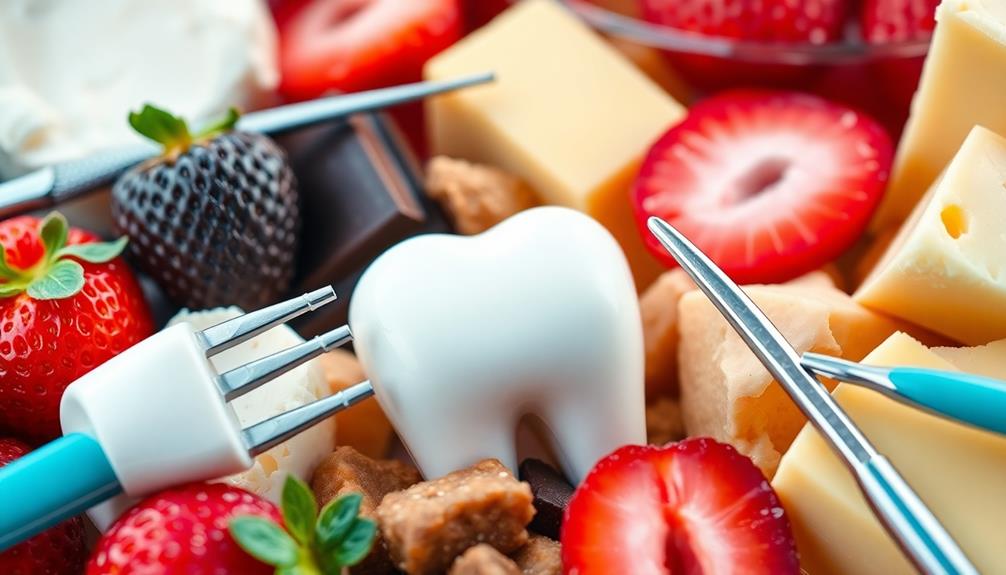
Your dental health is the secret ingredient to truly enjoying your meals. Healthy teeth and gums make chewing easier, allowing you to savor every bite. When you have dental issues, you might shy away from crunchy or sweet foods, limiting your choices and satisfaction. Plus, too much sugar can harm your teeth, reducing long-term enjoyment of treats. Warm beverages may also cause sensitivity, affecting your experience. By maintaining good oral health, you can explore a wider variety of nutritious options and truly enjoy your meals. Want to discover tips on how to protect your smile while enjoying food?
Key Takeaways
- Healthy teeth and gums enable effective chewing, enhancing the overall enjoyment of meals and food variety.
- Dental issues can limit food choices, causing pain that restricts the consumption of crunchy or nutritious foods.
- Excess sugar intake not only harms oral health but also diminishes the long-term satisfaction of enjoying food.
- Sensitivity to temperature and acidity can hinder the enjoyment of hot or cold meals, affecting social dining experiences.
- Prioritizing oral hygiene after eating can preserve dental health, ensuring continued enjoyment of a diverse diet.
The Role of Oral Health in Eating

When it comes to enjoying your meals, oral health plays a significant role. Your teeth and gums are essential for proper chewing, which directly affects your eating experience. If you're suffering from gum disease or tooth decay, you may find it painful to eat certain foods. This discomfort can lead you to avoid crunchy fruits and vegetables, which are key components of a balanced diet.
Traditional Ethiopian dishes, such as Yetimatim Fitfit, often rely on fresh ingredients that require good oral health for proper enjoyment. As a result, you might miss out on important nutrients that support overall health.
Maintaining healthy teeth and gums isn't just about preventing dental issues; it's also about enhancing your enjoyment of food. Studies show that individuals with good oral health report higher satisfaction with their meals. When your oral hygiene is on point, you can savor each bite without the fear of discomfort or pain.
Additionally, healthy teeth and gums support proper mastication, which is essential for effective nutrient absorption. By prioritizing your dental health, you'll not only prevent complications but also elevate your eating experience, allowing you to explore a wider variety of foods without hesitation.
Taking care of your oral health is a key step toward enjoying your meals to the fullest.
How Dental Issues Affect Food Choices
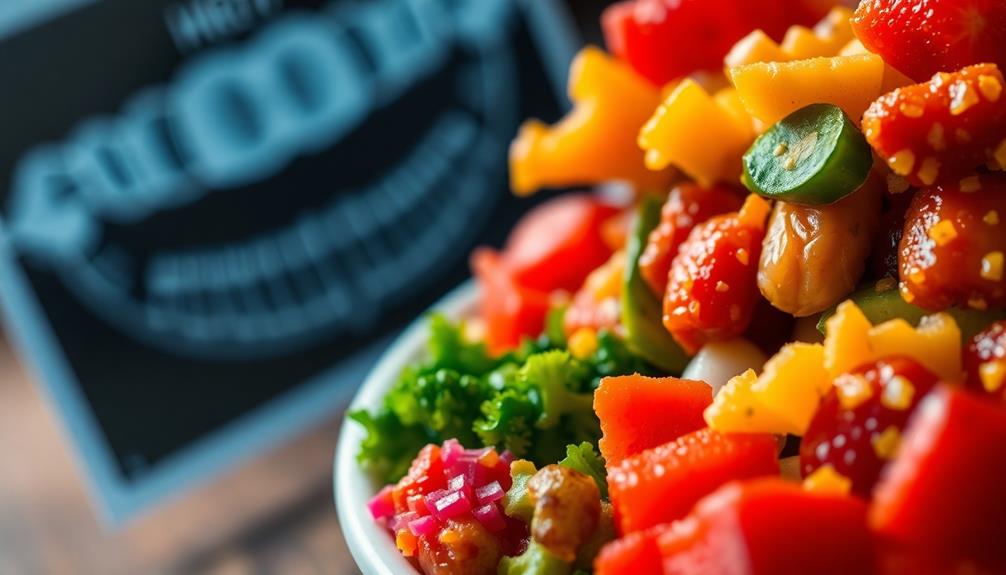
Dental issues can greatly impact your food choices and overall eating experience. When you face dental problems like cavities or gum disease, pain and discomfort often force you to avoid certain foods, especially those that are hard, crunchy, or overly sweet.
This avoidance limits your access to nutritious foods like fruits and vegetables, which are crucial for maintaining a healthy dietary balance. For instance, enjoying flavorful dishes like Mushroom Masala may become difficult if biting into even soft foods causes pain.
If you have tooth sensitivity, enjoying hot or cold meals becomes a challenge, affecting not just your meal satisfaction but also your social interactions. The fear of exacerbating dental pain can lead you to rely more on soft, processed foods that are typically higher in sugar and lower in important nutrients, further damaging your oral health.
As a result, poor oral health can greatly decrease your quality of life and dietary satisfaction. It's important to prioritize oral health care to promote your overall well-being.
The Impact of Sugar on Enjoyment

Sugar can have a significant impact on your enjoyment of food, particularly during festive seasons when indulgence is common. While sweet treats bring joy, excessive sugar consumption can lead to cavities and enamel erosion, ultimately diminishing your long-term enjoyment.
Traditional Brazilian desserts, like Brigadeiro, showcase the delightful use of sugar, but moderation is essential to prevent dental issues. Bacteria in your mouth thrive on sugar, producing harmful acids that contribute to dental problems. This can make eating and drinking less pleasurable.
Hidden sugars lurking in many festive foods only add to your overall sugar intake, increasing the risk of dental issues. Moderation is key; enjoying holiday sweets while balancing them with sugar-free alternatives helps maintain dental health and enhances your overall enjoyment of festive flavors.
Good oral hygiene practices after indulging are essential. Brushing your teeth and rinsing your mouth can prevent sugar-related damage, allowing you to savor your favorite foods without worry.
Warm Beverages and Sensitivity Issues

As the weather cools down, warm beverages like coffee, tea, and cider become favorites for many. However, you should be aware that these drinks can pose risks to your dental health. Their acidity can lead to tooth sensitivity and discomfort, especially if you're already prone to these issues.
Frequent consumption of acidic drinks contributes to enamel erosion, increasing the risk of cavities. Enjoying flavorful foods such as Red-Braised Pork Belly alongside these beverages can also heighten the risk of sensitivity due to the rich flavors and textures involved.
To enjoy your warm beverages without compromising your mouth hygiene, consider a few strategies. First, sip water between drinks. This simple habit helps neutralize acidity and reduces the potential for enamel wear.
Second, using straws can notably minimize contact between the drink and your teeth, which protects your enamel and reduces sensitivity.
If you already experience tooth sensitivity, be extra cautious with the temperature and acidity of your beverages. It's important to find a balance that allows you to savor your favorite warm drinks without exacerbating discomfort.
Navigating Holiday Treats Safely

The festive season brings a tempting array of holiday treats that can be hard to resist, but traversing them safely is key to protecting your dental health. Many holiday goodies are packed with sugar, which can lead to cavities and enamel erosion. Enjoying these treats in moderation is essential for maintaining good oral health.
For instance, consider using leftover turkey from Thanksgiving to create a satisfying turkey sandwich that can be enjoyed without the added sugars of many holiday desserts; Turkey Sandwich (For Leftovers) can be a delicious and healthier alternative. Be mindful of hidden sugars in festive foods; reading labels can help you choose healthier options.
When sipping on warm beverages like hot chocolate or spiced cider, remember they can cause tooth sensitivity. Alternating with water helps neutralize acidity and protect your teeth.
Crunchy treats, such as roasted nuts, can pose a risk of cracked teeth. To enjoy them safely, consider consuming them sliced or chopped.
After indulging in holiday treats, prioritizing dental care by brushing and flossing is vital for preserving your dental health.
Strategies for Enjoying Food Healthily

While holiday feasts can be delightful, finding ways to enjoy food healthily is vital for your overall well-being. You can savor your favorite foods without compromising your oral health. One great way to enhance your meals is by incorporating seasonal dishes like Nettle and Potato Soup, which not only provides nutritional benefits but also adds a unique flavor profile to your holiday table.
Here are some strategies to take into account:
- Prioritize moderation by limiting sugary treats, as excessive sugar can lead to cavities and enamel erosion.
- Choose sugar-free alternatives for holiday favorites to satisfy cravings without dental issues.
- Incorporate water breaks between acidic beverages like coffee or cider to neutralize acidity and protect your teeth.
- Opt for sliced or chopped crunchy snacks, such as nuts, to reduce the risk of cracked or chipped teeth.
Maintaining good oral care practices is essential. Brushing and flossing after meals effectively removes plaque and food particles, ensuring that your food enjoyment doesn't jeopardize your healthy smile.
Make regular dental visits a priority to further reduce the risk of dental problems. By following these tips, you can indulge in delicious foods and beverages while still keeping your oral health in check.
Frequently Asked Questions
What Is the Link Between Oral Health and Nutrition?
Your oral health directly affects your nutrition. Healthy teeth and gums enable you to chew and swallow effectively, while poor oral care can lead to pain, making it harder to enjoy a balanced diet.
How Does Food Affect Dental Health?
You might not realize it, but your favorite treats can harm your teeth. Sugary and acidic foods erode enamel, while crunchy snacks can crack teeth. Remember to rinse and practice good hygiene for healthier dental health.
What Is the Connection Between Dental Health and Overall Health?
Your dental health directly impacts your overall well-being. Poor oral hygiene can lead to systemic diseases, increase inflammation, and complicate conditions like diabetes, emphasizing the importance of maintaining good dental practices for better health.
What Are Three Risk Factors Associated With Dietary That Have Links to Poor Oral Health?
You should be wary of excessive sugar, as it leads to cavities. Also, acidic drinks can erode enamel, and frequent snacking creates acid attacks on your teeth. These factors considerably increase your risk of dental problems.
Conclusion
So, next time you're about to indulge in that gooey chocolate cake, remember: your dental health isn't just about avoiding the dentist's chair—it's also about savoring every bite without wincing. After all, who wants to choose between a bright smile and a slice of pie? Embrace the irony of loving food while battling plaque! With a little care, you can enjoy your treats and keep your teeth intact. Now, go ahead and crunch into that carrot stick—how thrilling!
-

 id4 months ago
id4 months agoPanduan Karir Internasional untuk Warga Indonesia
-

 id4 months ago
id4 months agoTemukan Keindahan Pendopo Jakarta sebagai Destinasi Anda
-

 id4 months ago
id4 months agoBerbagi Opini Anda – Wawasan untuk Indonesia
-
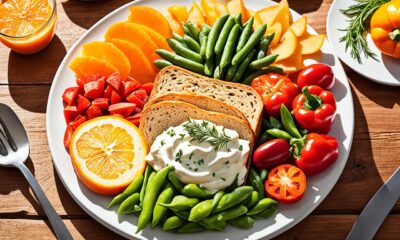
 id4 months ago
id4 months agoKesra Sebagai Pilihan Pangan Sehat untuk Keluarga
-

 id4 months ago
id4 months agoBerita-Terkini Indonesia: Info Terbaru Hari Ini
-

 id4 months ago
id4 months agoRahasia Sehat dengan Olahraga Rutin Anda
-

 News4 months ago
News4 months agoUnderstanding Ekonomi: Basics and Beyond
-

 News4 months ago
News4 months agoThe Heartbreaking Story of Tim Chapman's Wife



























